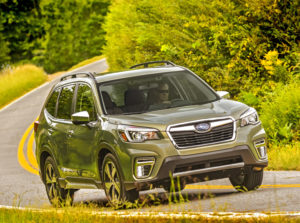
Subaru position statement: Use OEM components, follow procedures on structural parts
By onAnnouncements | Education | Repair Operations | Technology
Subaru last month released a position statement declaring repairers “should follow Subaru published repair procedures and use Subaru Genuine Parts” for all “unibody/structural components.”
According to Subaru, these parts include such common collision repair elements as “apron assemblies” and bumper reinforcement beams.
“For all repairs to unibody/structural components – (including frame rails, apron assemblies, quarter panels, floor structures, bumpers, bumper reinforcement bars, A-pillars, B-pillars, and body panels) – repair facilities should follow Subaru published repair procedures and use Subaru Genuine Parts,” Subaru wrote in the position statement. “These structural components are specifically designed to work in concert to protect the vehicle occupants and maintain cabin integrity.”
The OEM said you can’t repair parts if there’s not a procedure for whatever it is you’re trying to do.
“Repair procedures are available in vehicle-specific Service Manuals, Body Repair Manuals and Technical Service Bulletins,” Subaru wrote. “Structural components may be replaced individually when Subaru Genuine Parts are available. However, do not presume that if a component is available that there are published replacement procedures. If specifications and repair procedures are not available from Subaru, then the individual components are not repairable.”
The OEM noted the effect an improper repair could have upon a vehicle’s crashworthiness.
“All elements of an occupant supplemental restraint system, including but not limited to air bags, side-curtain air bags, and air bag deployment sensors, must work in concert with energy absorption components to provide proper timing for air bag deployment,” Subaru wrote.
“Compromising any element of a collision energy absorption system or an occupant supplemental restraint system in the repair of a collision-damaged vehicle may have an adverse effect on occupant safety in any subsequent collision.”
Subaru also said it “strongly recommends” that a certified shop in the automaker’s network handle all work and do so using OEM parts, “including all mechanical and electrical parts, body panels, and structural components.”
It warned that using something other than Subaru Genuine Parts could affect crashworthiness.
“Subaru does not support the use of aftermarket, alternative, or reverse-engineered components, or anything other than Subaru Genuine Parts for the collision repair of any Subaru vehicle,” Subaru wrote. “Additionally, Subaru does not support the use of parts that have been removed, salvaged or recycled from an existing vehicle. The use of non-OEM components that may not be manufactured to Subaru specifications or tolerances, or the use of alternative structural repair procedures, could compromise occupant safety in a subsequent collision.”
The company also recently tweaked its aftermarket parts position statement to add similar language on tolerances, certified shops and examples of components it wants to be Subaru Genuine Parts.
Subaru OEM repair procedures can be found at techinfo.subaru.com. Subaru recommends accessing it with the Internet Explorer browser (instead of Chrome, Firefox, etc.).
Repairers can get more details on using the software with a recently released Society of Collision Repair Specialists video of a 2019 OEM Collision Repair Technology Summit panel featuring Subaru and other automakers. Subaru itself has promoted the video to its certified auto body repair network.
Images:
Subaru “Structural Repairs” position statement
Subaru, March 2020
Subaru “Use of Aftermarket Substitute Parts on Subaru Vehicles” position statement
Subaru, March 2020
Subaru OEM repair procedures (works best in Internet Explorer)
“SCRS OEM Summit: FCA, Toyota, Subaru and Honda discuss OEM procedures and technical support”
Society of Collision Repair Specialists YouTube channel, April 2, 2020
Featured image: A 2019 Subaru Forester Touring is shown. (Provided by Subaru)
